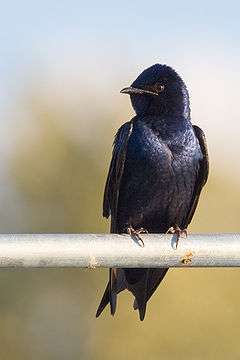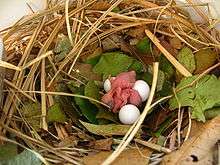Purple martin
| Purple martin | |
|---|---|
 | |
| Adult male | |
 | |
| Adult female | |
| Scientific classification | |
| Kingdom: | Animalia |
| Phylum: | Chordata |
| Class: | Aves |
| Order: | Passeriformes |
| Family: | Hirundinidae |
| Genus: | Progne |
| Species: | P. subis |
| Binomial name | |
| Progne subis (Linnaeus, 1758) | |
The purple martin (Progne subis) is the largest North American swallow. These aerial acrobats have speed and agility in flight, and when approaching their housing, will dive from the sky at great speeds with their wings tucked.
Description and taxonomy
Purple martins are a kind of swallow, of the genus Progne. Like other members of this genus, they are larger than most of the other swallows. The average length from bill to tail is 20 cm (7.9 in). Adults have a slightly forked tail. Adult males are entirely black with glossy steel blue sheen, the only swallow in North America with such coloration. Adult females are dark on top with some steel blue sheen, and lighter underparts. Subadult females look similar to adult females minus the steel blue sheen and browner on the back. Subadult males look very much like females, but solid black feathers emerge on their chest in a blotchy, random pattern as they molt to their adult plumage.[2]
This species was first described by Linnaeus in his Systema naturae in 1758 as Hirundo subis.[3] The current genus name refers to Procne (Πρόκνη), a mythological girl who was turned into a swallow to save her from her husband. She had killed their son to avenge the rape of her sister. The specific subis is Latin and refers to a type of bird that breaks eagles’ eggs; it may have been applied to this species because of its aggression towards birds of prey when it is nesting.[4]
The species of this genus are very closely related, and some view the purple martin, gray-breasted martin, snowy-bellied martin, and southern martin, as a superspecies.[5]
Subspecies
- P. s. subis, is the nominate form, with the typical features of the species, breeds in eastern and mid-western North America.
- P. s. hesperia of the Mexico and the southwestern United States, is distinguished primarily by its nesting habits.
- P. s. arboricola of western mountains is large with females paler on underparts.
Distribution and habitat

Purple martins' breeding range is throughout temperate North America. Their breeding habitat is open areas across eastern North America, and also some locations on the west coast from British Columbia to Mexico.[6] Martins make their nests in cavities, either natural or artificial. In many places, humans put up real or artificial hollow gourds, or houses for martins, especially in the east, where purple martins are almost entirely dependent on such structures. As a result, this subspecies typically breeds in colonies located in proximity to people, even within cities and towns. This makes their distribution patchy, as they are usually absent from areas where no nest sites are provided. Western birds often make use of natural cavities such as old woodpecker holes in trees or saguaro cacti.[2][5]
The purple martin migrates to the Amazon basin in winter. Its winter range extends into Ecuador[7] but does not seem to ascend far up the Andean foothills.
The first record of this species in Europe was a single bird on Lewis, Scotland, on 5–6 September 2004, and the second was on the Azores on 6 September 2004.
Conservation status


Purple martins suffered a severe population crash in the 20th century widely linked to the release and spread of European starlings in North America. Starlings and house sparrows compete with martins for nest cavities. Where purple martins once gathered by the thousands, by the 1980s they had all but disappeared. [8]
Relationship with humans
The population of eastern purple martins (nominate form P. s. subis) is dependent on artificial martin houses of wood or aluminum and fake plastic gourds, supplied by individuals and organizations fond of the bird. This tradition was in place even before the population crash; Native Americans are said to have hollowed out gourds and erected them for this purpose. The situation requires ongoing maintenance, as European starlings and house sparrows compete with martins as cavity-nesters, and will fight with martins over nest sites. Starlings have even been known to kill purple martins, especially nestling young, and house sparrows have been known to evict purple martins from their nests. Thus, unmonitored purple martin houses are often overtaken by more aggressive, non-native species.[2] Purple martin proponents are motivated by the concern that the purple martin would likely vanish from eastern North America were it not for this assistance.[9]
Behavior
Migration
Wintering in South America, purple martins migrate to North America in spring to breed. Spring migration is somewhat staggered, with arrivals in southern areas such as Florida and Texas in January, but showing up in the northern United States in April and in Canada as late as May. Males usually arrive at a site before females.[2]
Fall migration is also staggered, as birds head south when the breeding season is over. Some birds leave as early as July and others stay as late as October. Martins generally migrate over land, through Mexico and Central America. When not breeding, martins form large flocks and roost together in great numbers. This behavior begins just prior to the southern migration and continues on the wintering grounds.[2]
Breeding

Males arrive in breeding sites before females, and establish their territory. A territory can consist of several potential nest sites. After forming a pair, both the male and female inspect available nest sites. This process is complicated by the fact that artificial nest sites could be houses with many rooms, clustered gourds, or single gourds. The nest is made inside the cavity of such artificial structures and retains a somewhat flat appearance. The nest is a structure of primarily three levels: the first level acts as a foundation and is usually made up of twigs, mud, small pebbles and in at least a few reported cases, small river mollusk shells were used; the second level of the nest is made up of grasses, finer smaller twigs; the third level of construction composing the nest, is a small compression usually lined with fresh green leaves where the eggs are laid. Three to six eggs are laid, and the female is the main incubator, with some help from the male. Purple martins are generally known to raise only a single brood. Fledging, when the young leave the nest, occurs at about one month, after which the parents continue to feed the fledgling young.[2]
Diet
Purple martins are aerial insectivores, meaning that they catch insects from the air. The birds are agile hunters and eat a variety of winged insects. Rarely, they will come to the ground to eat insects. They usually fly relatively high, so, contrary to popular opinion, mosquitoes do not form a large part of their diet.[2] Recent research, however, does indicate that the Purple Martin feeds on invasive fire ants (Solenopsis invicta) and that they may make up a significant portion of their diet.[10]
Vocalization
Purple martins are fairly noisy, chirping and making sounds that have been described as chortles, rattles, and croaks.[5] The various calls are said to be "throaty and rich" and can be rendered as tchew-wew, pew pew, choo, cher, zweet and zwrack. The males have a gurgling and guttural courtship song, a dawn song, and even a subsong used at the end of the breeding season.[5][11] Tapes of purple martin song are sold to attract martins to newly established birdhouses.
 |
Purple martin
|
| Problems playing this file? See media help. | |
 |
Purple martin
|
| Problems playing this file? See media help. | |
Footnotes
- ↑ BirdLife International (2012). "Progne subis". IUCN Red List of Threatened Species. Version 2013.2. International Union for Conservation of Nature. Retrieved 26 November 2013.
- 1 2 3 4 5 6 7 Brown, Charles R. Purple Martin (Progne subis); The Birds of North America Online (A. Poole, eds. Ithaca: Cornell Lab of Ornithology http://bna.birds.cornell.edu/bna. Retrieved 1 November 2009. Missing or empty
|title=(help) - ↑ Linnaeus (1758
- ↑ Jobling, James A (2010). The Helm Dictionary of Scientific Bird Names. London: Christopher Helm. pp. 317, 371. ISBN 978-1-4081-2501-4.
- 1 2 3 4 Turner, Angela K.; Rose, Chris (1989). Swallows & Martins. Boston: Houghton Mifflin. pp. 7, 123–126. ISBN 0-395-51174-7.
- ↑ See AOU (2000) for details.
- ↑ Guayas and Orellana Provinces: Cisneros-Heredia (2006).
- ↑ Hunn, Eugene S. (1982). Birding in Seattle and King County. Seattle Audubon Society. pp. 107–108. ISBN 0914516051.
- ↑ "Purple Martin Conservation Association".
- ↑ Helms IV, Jackson A., Bridge, Eli S., Godfrey, Aaron P, and Ames, Tayna. (2015): The Purple Martin Update. "Fire Ant Exterminators". 24-27.
- ↑ Peterson (1980): p.202
References
- American Ornithologists' Union (AOU) (2000). Forty-second supplement to the American Ornithologists' Union Check-list of North American Birds. Auk 117(3): 847–858. DOI: 10.1642/0004-8038(2000)117[0847:FSSTTA]2.0.CO;2
- Cisneros-Heredia, Diego F. (2006). "Información sobre la distribución de algunas especies de aves de Ecuador". ["Information on the distribution of some species of birds of Ecuador"]. Boletín de la Sociedad Antioqueña de Ornitología 16(1): 7-16. [Spanish with English abstract]
- Linnaeus, Carolus (1758). Systema naturae per regna tria naturae, secundum classes, ordines, genera, species, cum characteribus, differentiis, synonymis, locis. Tomus I. Editio decima, reformata. (in Latin). Holmiae. (Laurentii Salvii). p. 192.
- Peterson, Roger Tory (1980). A Completely New Guide to All the Birds of Eastern and Central North America (4th ed.). Houghton Mifflin, Boston. ISBN 99975-1-436-X
External links
| Wikimedia Commons has media related to Purple martin. |
| Wikispecies has information related to: Progne subis |
- Purple Martin Conservation Association
- The Nature Society purple martin monthly publication and information
- The Purple Martin Society, NA
- Stamps (for Saint Vincent and the Grenadines) at bird-stamps.org
- "Purple Martin media". Internet Bird Collection.
- How to Help Purple Martins - National Audubon Society
- Purple Martin at Hinterland's Who's Who (Environment Canada & The Canadian Wildlife Federation)
- Purple Martin Bird Sound at Florida Museum of Natural History
- Purple Martin photo gallery at VIREO (Drexel University)
